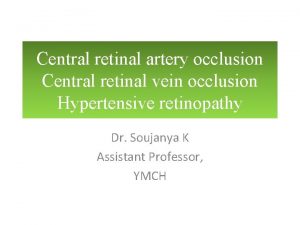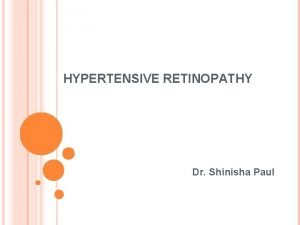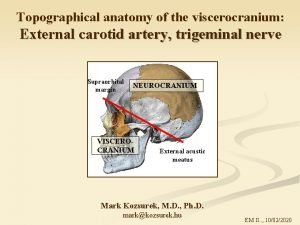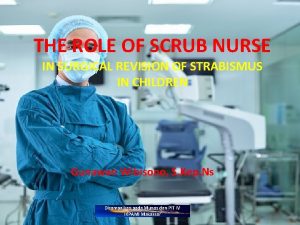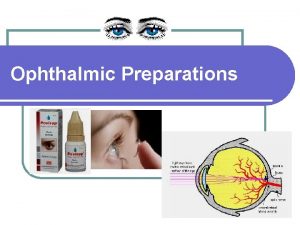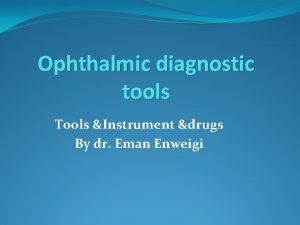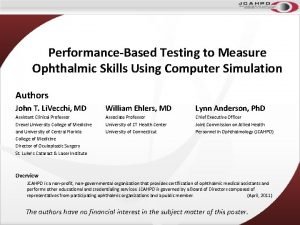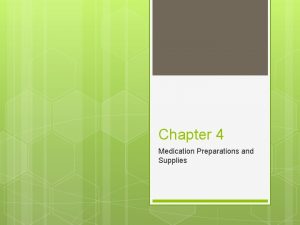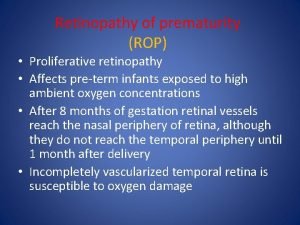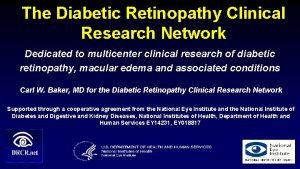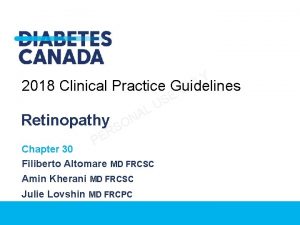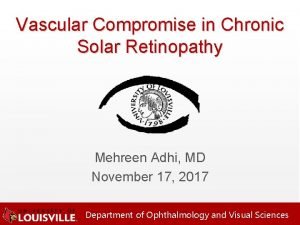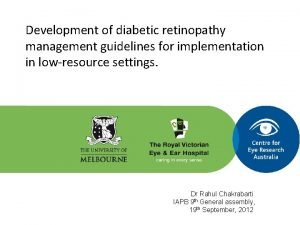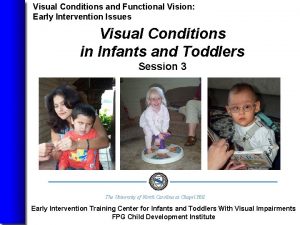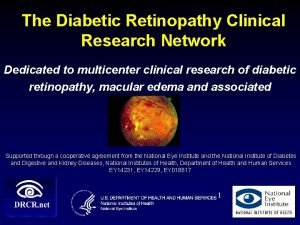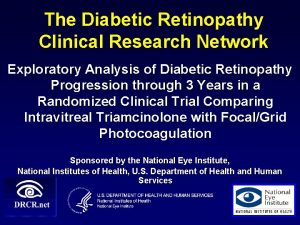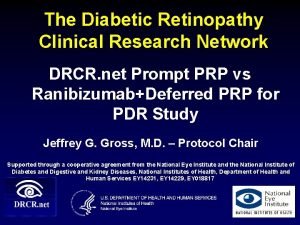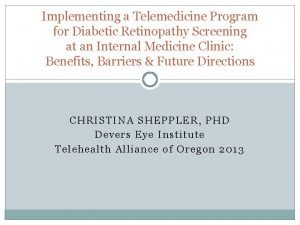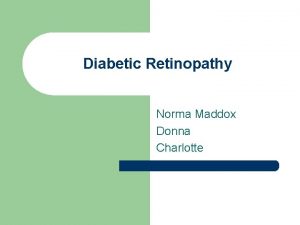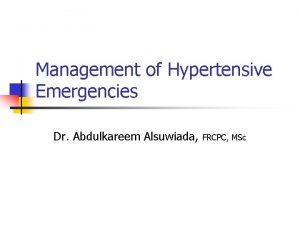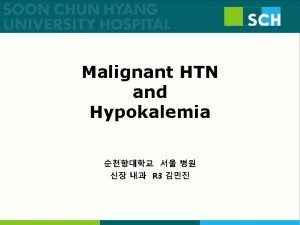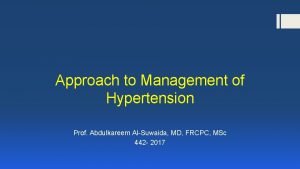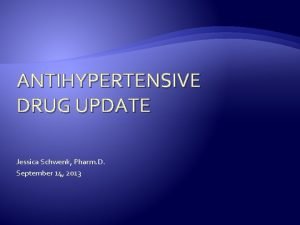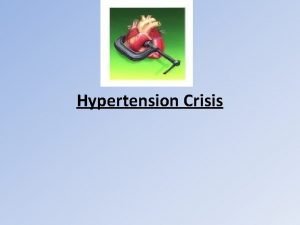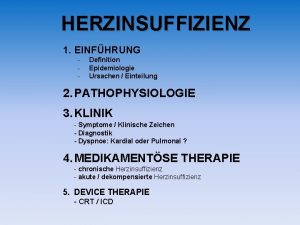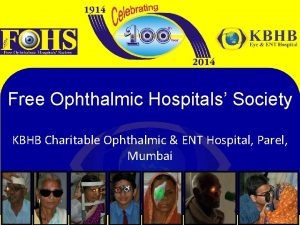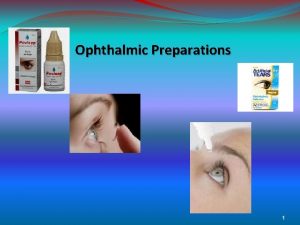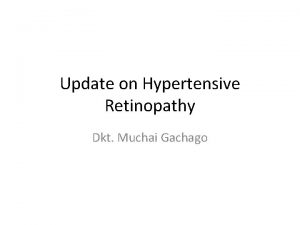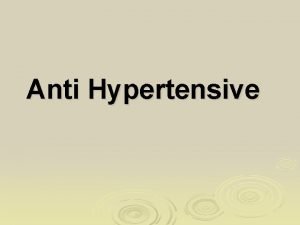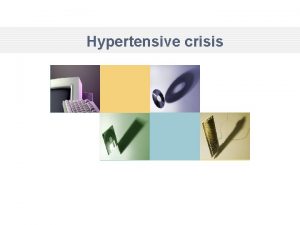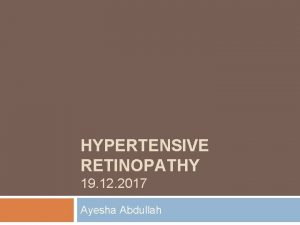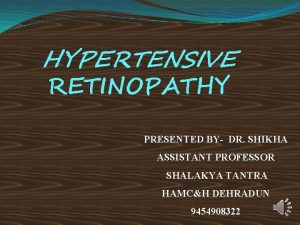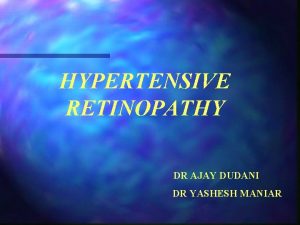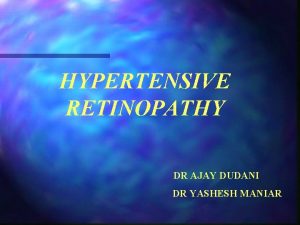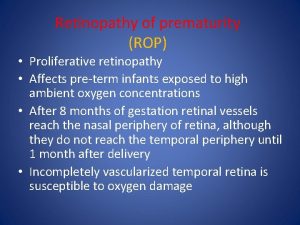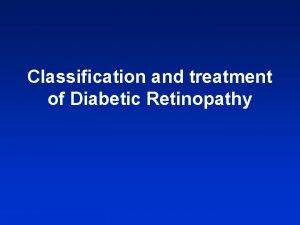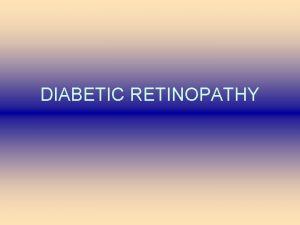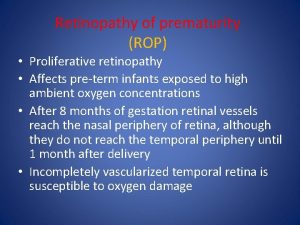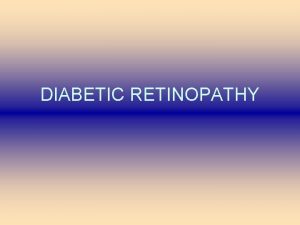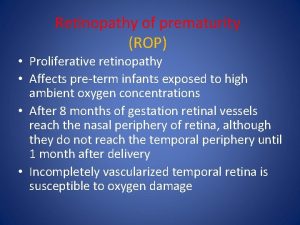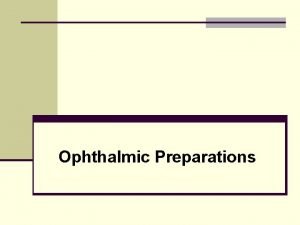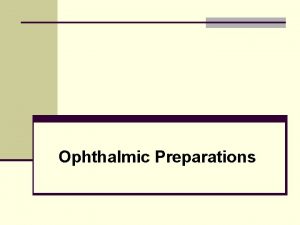HYPERTENSIVE RETINOPATHY Dr Shinisha Paul introduction Ophthalmic findings

































- Slides: 33

HYPERTENSIVE RETINOPATHY Dr. Shinisha Paul

introduction Ophthalmic findings of end organ damage secondary to systemic hypertension affects precapillary arterioles and capillaries Uncontrolled systemic hypertension leads to nonperfusion at various retinal levels and to neuronal loss

Retinal blood supply Retinal blood vessels and choroidal blood vessels Ophthalmic artery central retinal artery posterior ciliary arteries long posterior ciliary Short posterior ciliary Anterior choriocapillaries Posterior choriocapillaries


Outer layers are avascular – diffusion from the choriocapillaries Central retinal artery – end artery Retinal veins are in inner retina and interdigitate with veins Artery lies anterior to vein (common adventitial coat)



Pathophysiology Arteriosclerosis – breakdown in autoregulation High pressure in arterioles transmitted to capillaries Capillary closure or hemorrhage


Clinical features Asymptomatic Headache Blurred vision Transient vision loss

Changes in hypertensive retinopathy Focal arteriolar narrowing and arterial venous nicking – sclerosis Flame hemorrhages blot hemorrhages Microaneurysm hard exudates Cotton wool spots Optic disc swelling






AV crossing changes: � Venous deflection – salus sign � Venous nipping – gunn sign � Distal banking – bonnet sign





Classification Keith Wagner and Barker Grade 1 - Mild to moderate narrowing Grade 2 - a. There is moderate to marked narrowing of retinal arterioles. b. Copper wire reflex c. Typical arteriovenous crossing changes Grade 3 – a. retinal arteriolar narrowing and focal constriction. b. Silver wire appearance c. Retinal oedema d. Cotton wool or soft exudates e. Superficial flame-shaped haemorrhages

Grade 4 : grade 3 and macular star with papilledema

Modified Scheie Classification of "Hypertensive Retinopathy": Grade 0 - No changes Grade 1 - Barely detectable arterial narrowing Grade 2 - Obvious arterial narrowing with focal irregularities Grade 3 - Grade 2 plus retinal hemorrhages and/orexudates Grade 4 - Grade 3 plus disc swelling



Hypertensive Choroidopathy Typically occurs in young patients episode of acute hypertension associated with preeclampsia, pheochromocytoma, or renal hypertension Elschnig spots - non perfused choriocapillaries Siegrist streaks - hyperpigmented streaks



Pregnancy induced hypertension Hypertension in pregnant women after 20 weeks of gestation Symptoms : Rapid or sudden weight gain, high blood pressure, protein in the urine, and swelling in the hands, feet, and face Blurry vision, spots before your eyes that don’t resolve. Related to vascular endothelial dysfunction Exudative retinal detachment - choroidal ischemia

Risk factors for PIH Is under age 20 or over age 35 Has a history of chronic hypertension Has a previous history of PIH Has a female relative with a history of PIH Is underweight or overweight Has diabetes before becoming pregnant Has an immune system disorder, such as lupus or rheumatoid arthritis Has kidney disease Has a history of alcohol, drug, or tobacco use Is expecting twins or triplets

Treatment Grade 1 -3 : control of hypertension Grade 4 : immediate intervention (Malignant hypertension) PIH : regular fundus examination

Thank you
 Grading of oedema
Grading of oedema Modified scheie classification
Modified scheie classification Maxillary artery
Maxillary artery Ophthalmic scrub nurse
Ophthalmic scrub nurse Ophthalmic mutual insurance company
Ophthalmic mutual insurance company Ophthalmic preparation definition
Ophthalmic preparation definition Ophthalmic diagnostic agents
Ophthalmic diagnostic agents Vascular pigmented coat
Vascular pigmented coat Ophthalmic medical terminology
Ophthalmic medical terminology Ophthalmic technician skills checklist
Ophthalmic technician skills checklist Sterile semisolid preparations for ophthalmic use only are
Sterile semisolid preparations for ophthalmic use only are Retino patia
Retino patia Albany diabetic retinopathy
Albany diabetic retinopathy Diabetic retinopathy clinical research network
Diabetic retinopathy clinical research network Diabetic retinopathy cpg
Diabetic retinopathy cpg Solar retinopathy
Solar retinopathy Diabetic retinopathy grading
Diabetic retinopathy grading Diabetic retinopathy
Diabetic retinopathy Eibschitz-tsimhoni
Eibschitz-tsimhoni Diabetic retinopathy clinical research network
Diabetic retinopathy clinical research network Diabetic retinopathy clinical research network
Diabetic retinopathy clinical research network Diabetic retinopathy clinical research network
Diabetic retinopathy clinical research network Drcr net
Drcr net Diabetic retinopathy clinical research network
Diabetic retinopathy clinical research network Diabetic retinopathy screening reimbursement
Diabetic retinopathy screening reimbursement Diabetic retinopathy charlotte nc
Diabetic retinopathy charlotte nc Hypertensive emergency vs urgency
Hypertensive emergency vs urgency Malignant hypertension treatment
Malignant hypertension treatment Hypertensive urgency criteria
Hypertensive urgency criteria Hypertensive urgency vs emergency
Hypertensive urgency vs emergency Case scenario for hypertension
Case scenario for hypertension Périlimbique
Périlimbique Nursing management of thyrotoxicosis
Nursing management of thyrotoxicosis Hypertensive kardiopathie definition
Hypertensive kardiopathie definition
